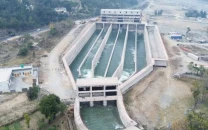Sugar: The profits of scarcity
The recurring nature of the sugar crises reveal the interlocking nature of the economic and political interests.

The industry is built on a vested advantage for political incumbents, not the comparative advantage of economic agents. In fact, Pakistan has no natural advantage in the production of sugar. Sugarcane is a water-intensive crop, carrying significant costs for a water-scarce country like Pakistan. There is a high opportunity cost for resources used in its production — whether they are land, water or capital.
With disproportionate amounts of water and more than one million hectares of agricultural land devoted to its cultivation, sugarcane production is a high-cost proposition. Agricultural productivity remains abysmally low, as demonstrated by the low yields per acre. Despite this, the cultivation area for sugar has expanded more rapidly over the last 60 years than any other crop. There are widespread market distortions in all stages of the value chain, from the purchase of sugarcane to its processing and distribution. And there is strong evidence of collusive practices in the industry.
These inefficiencies drive a wedge between domestic and world prices of sugar, increasing the industry’s dependence on state support. Even when sugar fetches a high price in the retail market, it does not necessarily translate into better incentives for farmers. With much of the profit skimmed away by mill owners and intermediaries, farmers often get a raw deal. Sugarcane growers have weak bargaining power, making them susceptible to manipulation by processors. Frequently, there are delays in the crushing season and farmers have to wait for months before their arrears are paid. Any astute observer of agricultural markets would confirm that the timing of the crushing season is itself political, designed to secure an advantage to mill owners.
Given these inefficiencies, sugar has a limited potential as an export crop. There is little prospect of obtaining a comparative advantage in future: export parity prices are higher in Pakistan than those prevailing in the international market. Perhaps, the only limited case for sugar production rests on the arguments for self-sufficiency — the idea that we can save precious foreign exchange by substituting for imports. But despite all the implicit subsidies that the industry has received, we are becoming increasingly dependent on imports. Thus, judged by any economic criteria, domestic production of sugar is not based on a rational allocation of resources.
While there is limited economic logic to producing sugar, there is an important political rationale for the industry’s existence. It offers a creative avenue for extracting resources from society and transferring them to private pockets. Back in the 1980s, entry into the sugar industry offered quick gains to old agricultural elite and new industrial barons. Sugar mills were officially sanctioned to connected individuals and financed through loans given by state-owned banks — loans that were seldom paid back. Heavily over-priced sugar plants from Ittefaq Foundries, duly paid for by national banks, were simply an icing on the cake for our new prophets of good governance, the Sharif brothers of Punjab.
And, even as economic competition is noted for its absence, political elite actively competed for spoils. Today, members of the PML-N own the largest number of mills, followed by leaders of the PML-Q. Stalwarts of the People’s Party, most notably President Asif Ali Zardari and the Mirzas from Sindh, are also major stakeholders. In fact, mapping the pattern of ownership in the sugar industry can allow us to map the power structure of Punjab and Sindh. This poses a dilemma for some of our media pundits who are impatient for political change. A regime change is likely to replace one set of rentiers with another. There is no hope for meaningful change unless we can alter the underlying distribution of economic power.
Published in The Express Tribune, November 12th, 2010.













COMMENTS
Comments are moderated and generally will be posted if they are on-topic and not abusive.
For more information, please see our Comments FAQ